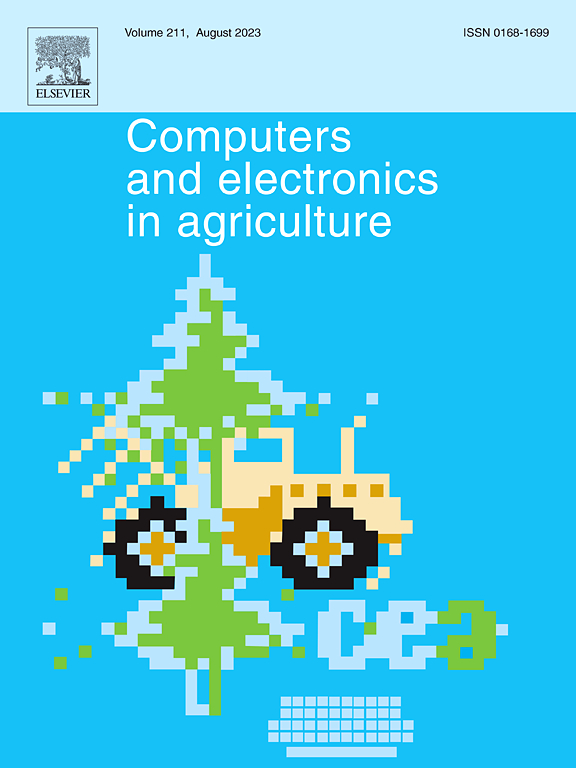Fluorescence-based sensing for leaf nicotine prediction, nitrogen estimation and variable rate fertilization of tobacco
IF 7.7
1区 农林科学
Q1 AGRICULTURE, MULTIDISCIPLINARY
引用次数: 0
Abstract
Sustainable and low-nicotine production of tobacco requires rapid and accurate on-site assessment of the leaf nitrogen (N) status. This issue can be supported by fluorescence-based sensors, which are promising tools for precision N management.
We then aimed to 1) evaluate the suitability of the Multiplex® fluorescence sensor (Mx) to predict, at an early stage, the final nicotine content of tobacco leaves; 2) develop a model for in-season tobacco foliar N estimation using the Partial Least Square (PLS) multivariate regression technique; and finally, 3) test the effectiveness of a Mx map-based Variable Rate Nitrogen Fertilization (VRNF) in reducing the spatial variability in leaf Nitrogen Balance Index (NBI), that is the N status, of a commercial field of Virginia Bright tobacco.
The NBI measured by the Mx about two months after transplanting was found to linearly relate to the nicotine content measured after curing (R2 = 0.72, P < 0.001) over a nicotine range of 0.25 – 4.12 %. NBI, defined as the ratio between the leaf chlorophyll (SFRR) and Flavonoids (FLAV) indices better related to nicotine than the single SFRR and FLAV indices (R2 = 0.47, P < 0.001 and R2 = 0.52, P < 0.001, respectively. Furthermore, the NBI estimated the actual leaf N content before flowering better (R2 = 0.33) than single SFRR and FLAV indices (R2 = 0.28), over a range of 21 – 37.6 mgg−1.
Leaf fluorescence sensor indices were thus combined with growth stages and weather variables across diverse varieties and sites. The resulting PLS model successfully predicted leaf N (R2 = 0.72, RMSEP = 2.73 mgg−1 and relMAE = 7.75 %) over a range of 20.6–28.0 mgg−1. The most significant variables, primarily related to solar radiation, were identified for a robust general model development.
Finally, the spatial pattern of the NBI was mapped over a 2.04 ha commercial plot of the ITB 6118 variety, and used to produce a three-zone prescription map. Two weeks after the intervention of VRNF based on the defined prescription map, the overall NBI variability had dropped from 23.5 % coefficient of variation (CV) to 7.9 % CV.
Our results show the feasibility of using the Mx sensor for precision fertilization of Virginia Bright tobacco and highlight its potential to support future developments aimed at more sustainable production of plants with reduced nicotine content.

烟草叶片烟碱预测、氮素估算和变速率施肥的荧光传感研究
烟草的可持续和低尼古丁生产需要快速和准确的现场评估叶片氮(N)状态。这个问题可以通过基于荧光的传感器来支持,这是精确管理N的有前途的工具。然后,我们的目的是1)评估Multiplex®荧光传感器(Mx)在早期预测烟叶最终尼古丁含量的适用性;2)利用偏最小二乘(PLS)多元回归技术建立烟叶季节性氮估计模型;最后,验证基于Mx图的变氮施肥(VRNF)对降低弗吉尼亚白烟商业田叶片氮素平衡指数(NBI)的空间变异的有效性。移栽后2个月左右Mx测得的NBI与固化后测得的尼古丁含量呈线性相关(R2 = 0.72, P <;0.001),尼古丁含量在0.25 - 4.12%之间。NBI,定义为叶片叶绿素(SFRR)和黄酮类化合物(FLAV)指数与尼古丁的相关性优于单一SFRR和FLAV指数之比(R2 = 0.47, P <;0.001, R2 = 0.52, P <;0.001,分别。此外,NBI在21 ~ 37.6 mg−1的范围内,比单一的SFRR和FLAV指数(R2 = 0.28)更好地估算出开花前叶片实际氮含量(R2 = 0.33)。因此,叶片荧光传感器指数与不同品种和地点的生长阶段和天气变量相结合。所得到的PLS模型成功地预测了叶片N (R2 = 0.72, RMSEP = 2.73 mg - 1, relMAE = 7.75%)在20.6-28.0 mg - 1范围内。最重要的变量,主要与太阳辐射有关,被确定为一个稳健的一般模式发展。最后,在一个2.04 ha的ITB 6118品种商业地块上绘制了NBI的空间格局,并用于生成三区处方图。根据定义的处方图进行VRNF干预两周后,总体NBI变异系数(CV)从23.5%下降到7.9%。我们的研究结果表明,使用Mx传感器对弗吉尼亚白烟进行精确施肥的可行性,并强调了其支持未来发展的潜力,旨在以更可持续的方式生产尼古丁含量更低的植物。
本文章由计算机程序翻译,如有差异,请以英文原文为准。
求助全文
约1分钟内获得全文
求助全文
来源期刊

Computers and Electronics in Agriculture
工程技术-计算机:跨学科应用
CiteScore
15.30
自引率
14.50%
发文量
800
审稿时长
62 days
期刊介绍:
Computers and Electronics in Agriculture provides international coverage of advancements in computer hardware, software, electronic instrumentation, and control systems applied to agricultural challenges. Encompassing agronomy, horticulture, forestry, aquaculture, and animal farming, the journal publishes original papers, reviews, and applications notes. It explores the use of computers and electronics in plant or animal agricultural production, covering topics like agricultural soils, water, pests, controlled environments, and waste. The scope extends to on-farm post-harvest operations and relevant technologies, including artificial intelligence, sensors, machine vision, robotics, networking, and simulation modeling. Its companion journal, Smart Agricultural Technology, continues the focus on smart applications in production agriculture.
 求助内容:
求助内容: 应助结果提醒方式:
应助结果提醒方式:


